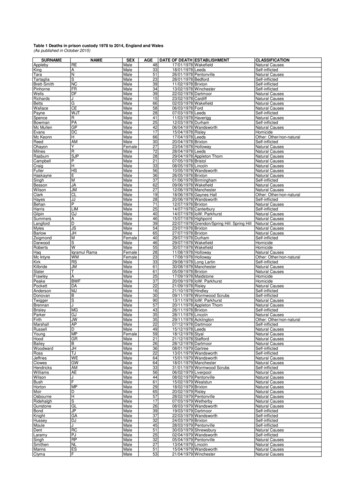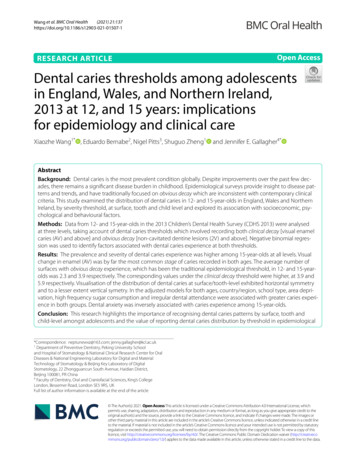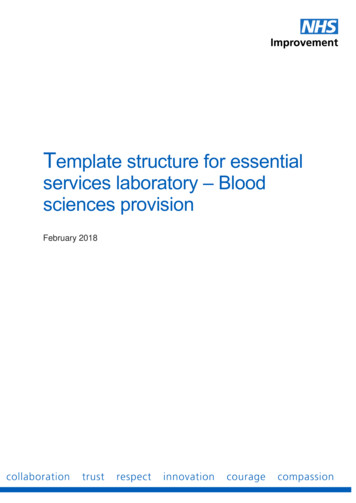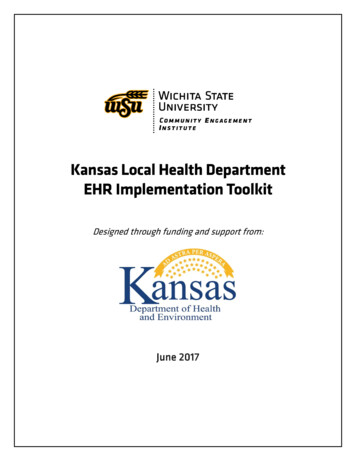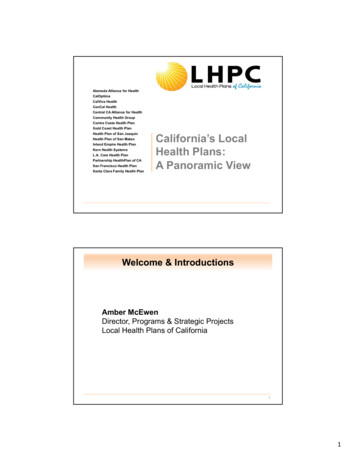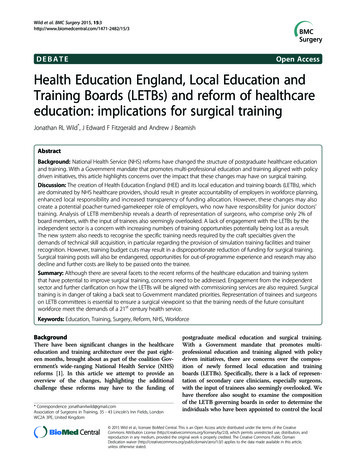
Transcription
Wild et al. BMC Surgery 2015, ATEOpen AccessHealth Education England, Local Education andTraining Boards (LETBs) and reform of healthcareeducation: implications for surgical trainingJonathan RL Wild*, J Edward F Fitzgerald and Andrew J BeamishAbstractBackground: National Health Service (NHS) reforms have changed the structure of postgraduate healthcare educationand training. With a Government mandate that promotes multi-professional education and training aligned with policydriven initiatives, this article highlights concerns over the impact that these changes may have on surgical training.Discussion: The creation of Health Education England (HEE) and its local education and training boards (LETBs), whichare dominated by NHS healthcare providers, should result in greater accountability of employers in workforce planning,enhanced local responsibility and increased transparency of funding allocation. However, these changes may alsocreate a potential poacher-turned-gamekeeper role of employers, who now have responsibility for junior doctors’training. Analysis of LETB membership reveals a dearth of representation of surgeons, who comprise only 2% ofboard members, with the input of trainees also seemingly overlooked. A lack of engagement with the LETBs by theindependent sector is a concern with increasing numbers of training opportunities potentially being lost as a result.The new system also needs to recognise the specific training needs required by the craft specialties given thedemands of technical skill acquisition, in particular regarding the provision of simulation training facilities and trainerrecognition. However, training budget cuts may result in a disproportionate reduction of funding for surgical training.Surgical training posts will also be endangered, opportunities for out-of-programme experience and research may alsodecline and further costs are likely to be passed onto the trainee.Summary: Although there are several facets to the recent reforms of the healthcare education and training systemthat have potential to improve surgical training, concerns need to be addressed. Engagement from the independentsector and further clarification on how the LETBs will be aligned with commissioning services are also required. Surgicaltraining is in danger of taking a back seat to Government mandated priorities. Representation of trainees and surgeonson LETB committees is essential to ensure a surgical viewpoint so that the training needs of the future consultantworkforce meet the demands of a 21st century health service.Keywords: Education, Training, Surgery, Reform, NHS, WorkforceBackgroundThere have been significant changes in the healthcareeducation and training architecture over the past eighteen months, brought about as part of the coalition Government’s wide-ranging National Health Service (NHS)reforms [1]. In this article we attempt to provide anoverview of the changes, highlighting the additionalchallenge these reforms may have to the funding of* Correspondence: jonathanrlwild@gmail.comAssociation of Surgeons in Training, 35 - 43 Lincoln’s Inn Fields, LondonWC2A 3PE, United Kingdompostgraduate medical education and surgical training.With a Government mandate that promotes multiprofessional education and training aligned with policydriven initiatives, there are concerns over the composition of newly formed local education and trainingboards (LETBs). Specifically, there is a lack of representation of secondary care clinicians, especially surgeons,with the input of trainees also seemingly overlooked. Wehave therefore also sought to examine the compositionof the LETB governing boards in order to determine theindividuals who have been appointed to control the local 2015 Wild et al.; licensee BioMed Central. This is an Open Access article distributed under the terms of the CreativeCommons Attribution License (http://creativecommons.org/licenses/by/2.0), which permits unrestricted use, distribution, andreproduction in any medium, provided the original work is properly credited. The Creative Commons Public DomainDedication waiver ) applies to the data made available in this article,unless otherwise stated.
Wild et al. BMC Surgery 2015, get for education and training and which disciplineshave their interests promoted at the LETB board level.DiscussionReasons for changeAlthough changes to education and training were initiallybranded an afterthought to the Government’s wider reforms [2] a policy framework for a new approach to education and training of the healthcare workforce was setout in Liberating the NHS: Developing the HealthcareWorkforce – From Design to Delivery [3], and from April2013 these plans came into effect. The Government claimsthat reform of the healthcare education and training system has been necessary in order to provide a workforcethat is capable of delivering 21st century care. With a stagnant health service budget the NHS is faced with an ageing population, increased demands for novel treatments,changing patterns of care, an expectant public and concerns over quality and patient safety following the reportsinto care failings by Robert Francis QC [4] and Sir BruceKeogh [5]. Proposals in Shape of Training – a recent review of postgraduate medical training led by economistProfessor Greenaway [6], also outline the need for trainingto be changed to ensure future medical graduates can provide general care in broader-based specialties. Therefore,in order to serve the needs of patients and the public witha workforce that has the knowledge and skill-set to provide safe, effective and compassionate care, the reformsset out the need for greater efficiency and transparency inthe investments made in education and training with asystem that has national oversight and is flexible for localworkforce needs.Page 2 of 8based training, ensuring there is capacity in the NHS todeliver training to a high standard and promotes academic disciplines.HEE will develop an allocation policy to ensure efficiency and transparency of the flow of funding to theLETBs of the 4.8 billion multi professional educationand training (MPET) budget to the LETBs, which comprises of the service increment for teaching (SIFT), themedical and dental education levy (MADEL) and thenon-medical education and training (NMET) fundingstreams. Initially a tariff based system for education andtraining will be implemented, with the longer-term possibility for MPET to be funded by a training levy on allproviders, which would allow the collection of a contribution from independent providers of healthcare whoemploy and benefit from staff trained by the NHS.Mechanisms have been developed to ensure efficiencyand transparency of the flow of funding for educationand training from HEE to its LETBs, and an Educationand Outcomes Framework (EOF) is being developed,which will set clear outcomes for the education andtraining system and the consequential impact on the patient experience, care and safety [8] enabling the allocationof education and training resources to be linked to quantifiable quality outcomes [9]. HEE is therefore likely to havegreater influence than Medical Education England (MEE),which it has replaced, as it acts as the body responsiblefor improving the quality of education and training inaddition to controlling the purse-strings. However, thelast minute cuts to the MPET budget by the Departmentof Health, where HEE discovered they were to receive 150 million less than expected for 2012/13, [10] meanthat any new found influence may well be dampened.Health Education EnglandThe main elements of the healthcare education and training reforms have been the formation of Health EducationEngland (HEE) and its 13 LETBs, which have absorbedthe function of the postgraduate deaneries and have replaced education and training functions of the former 10regional strategic heath authorities (see Figure 1).HEE is a statutory body with the responsibility to provide national leadership and oversight on strategic planning and development of the healthcare workforce inresponse to workforce intelligence and changing patientneeds [7]. It is the first time a single organisation hashad the responsibility for the education, recruitment,training and development of the entire NHS healthcareworkforce. As part of HEE’s advisory structure, there aresix advisory groups (HEEAGs) who will promote the interests of the medical, dental, nursing, pharmacy, healthcare science and allied healthcare professional groups.The Medical Advisory Group provides national levelrepresentation of the medical profession and is responsible for medical recruitment, supporting curriculum-The Government’s mandate for education and trainingand an integrated multi-disciplinary trainingThe recently published Government mandate to HEE[11] has been dubbed the “blueprint for NHS staff training” [12]. It is aligned with national NHS priorities totackle preventable deaths, support people living withchronic health problems, to increase patient access topsychological therapies and to improve the diagnosisand management and care for people with dementia,including providing dementia awareness for all frontlineNHS staff. General Practitioners (GPs), midwives, pharmacists, healthcare assistants (HCAs), community nursesand health visitors are the priority target staff groups,with an emphasis on a shift to community care. In response to the Francis Report, training is to be focussedon promoting a culture of caring with those who embark on a nursing degree to serve a year as a HCA andthere are moves to ensure clearer and more effectivecareer paths for HCAs including routes into senior careassistant roles and professional training. There appears
Wild et al. BMC Surgery 2015, e 3 of 8Figure 1 Health Education England and its LETBs.to be a firm focus on integrated multi-disciplinarytraining, with the mandate stating that “where appropriate [training] should incorporate working in multiskilled teams reflecting care pathways rather than exclusively professional groupings” [11].Local education and training boardsThe LETBs offer a forum for healthcare providers andprofessionals to improve the quality of education andtraining outcomes within their local area and ensurethe supply of the local NHS healthcare workforce,
Wild et al. BMC Surgery 2015, e 4 of 8whilst supporting national workforce priorities. The governing board of each LETB determines local arrangementsfor the commissioning of education and training throughallocation of its share of the MPET budget. Some LETBshave sub-committees, such as Local Education TrainingCouncils (LETCs) and professional advisory groups inorder for the LETB to engage with stakeholders. However,with no standard model for LETBs to follow there is thepotential for regional variability in how each LETB functions, which is perhaps why 9 out of the 13 LETBS haveconditions imposed on their authorisation, including involvement of HEE to determine the make-up of theirboards [13].Who sits on the LETB boards?To determine who sits on the 13 LETB boards and whichprofessional interests are represented we obtained lists ofLETB board members via the HEE websites, as of June2013. If details were not available online the LETB wascontacted directly for the information on the role andbackground of LETB board members.Each LETB has a Managing Director, a Director of Education and Quality (DEQ), who is responsible for the quality management of education and training programmescommissioned or provided by the LETB, both employedby HEE, an Independent Chair, whose role is to ensureconflicts of interest do not diminish the LETBs effectiveness and a Head of Finance [14]. Postgraduate MedicalDeans are also LETB board members, with some nowundertaking the role of DEQ (see Figure 1).The majority (59%) of the 231 LETB governing boardmembers are representatives of NHS health service providers (see Table 1). In the main these provider representatives are chief executives and senior managers of localNHS trusts, 30% of whom have a background in nursing.Education providers represent 12% of LETB members andjust 10% primarily represent the training interests ofhealthcare professionals, including the postgraduate deansand DEQs. Only one LETB, HEE North Central and EastLondon, has a trainee, medical student and patient representative on their board. Of the 66 medically qualifiedLETB board members, 30 (45%) represent NHS serviceproviders, with the majority of these (73%) being GP providers (see Table 2). Broken down by specialty, there areonly 4 surgeons, representing under 2% of total LETBgoverning board membership. Thirty four (52%) of thoseLETB board members who are medically qualified aregeneral practitioners with the acute medical specialtiesrepresented by 17 (26%) of these medically qualified boardmembers.Provider led commissioning of education and training poachers-turned-gamekeepers?It is clear that the LETBs reflect the Government’s ambition that they are very much service provider led. Education providers, the local universities and medical schoolsare also entitled to serve on the board [14] although thisdoes not appear to be the case in all LETBs. It is thehealthcare service providers who are therefore chiefly responsible for educating and training doctors, dentists,Table 1 The proportion of LETB board membership revealing the LETBs are dominated by service providers andadministratorsLETBLETB board membershipHealth tratorHealthcare tientEast Midlands10(71%)1(7%)2(14%)1(7%)0(0%)0(0%)14East of England11(65%)2(12%)3(18%)1(6%)0(0%)0(0%)17Kent Surrey Sussex (KSS)11(65%)3(18%)2(12%)1(6%)0(0
Training Boards (LETBs) and reform of healthcare education: implications for surgical training Jonathan RL Wild*, J Edward F Fitzgerald and Andrew J Beamish Abstract Background: National Health Service (NHS) reforms have changed the structure of postgraduate healthcare education and training. With a Government mandate that promotes multi-professional education and training aligned with policy




